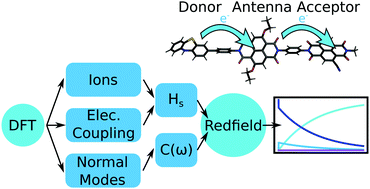Computational construction of the electronic Hamiltonian for photoinduced electron transfer and Redfield propagation†
Abstract
The construction of open-system diabatic Hamiltonians relevant for investigation of electron transfer processes is a computational challenge. In this paper, we present how the full system Hamiltonian, as well as relevant system-bath coupling parameters can be computed from a purely computational starting point. We have investigated two methods for calculating electronic couplings, Generalized Mulliken Hush (GMH) and Fock Matrix Reconstruction (FMR). We apply these methods to calculate the couplings in a model molecular triad, thus constructing the system-Hamiltonian in a diabatic basis. The triad is constructed with a donor–antenna–acceptor type architecture, and a two-step photoinduced electron transfer is expected in this system. With the calculated electronic couplings in combination with Huang–Rhys type electron–phonon couplings, we are able to construct two open-system Hamiltonians from a computational bottom-up approach, where the phonon-reservoir is approximated as harmonic oscillators. Based on these Hamiltonians, two separate propagations of populations are performed using the Redfield formalism. Based on the dynamics, we observe small differences between the results from the GMH and FMR simulations. The overall picture is similar for the two methods. Thereby, we conclude that the FMR approach is suitable as an initial screening tool for identifying long-lived photoinduced charge separated states and that a GMH based Hamiltonian can then be constructed to scrutinize promising candidate molecules. Furthermore, either method can be used to construct all relevant operators needed for the Redfield tensor, without prior knowlegde from experimental data.



 Please wait while we load your content...
Please wait while we load your content...